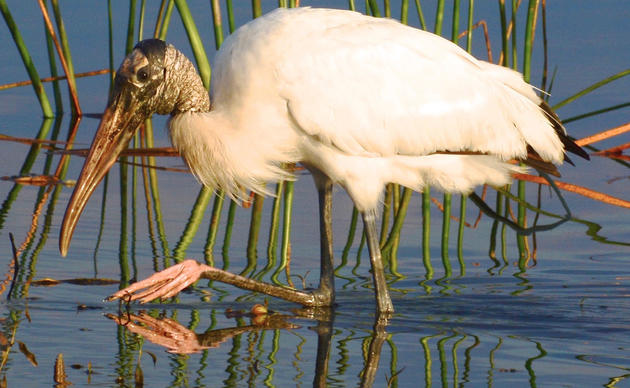HYDROLOGY
Water is the life blood of south Florida. Water levels are strategically monitored throughout Corkscrew Swamp Sanctuary using staff gauges and either analog or digital rainfall gauges. Hydrologic data are entered into a computer database where they can be statistically analyzed. Such data can be used to track water level fluctuations as a function of precipitation over time, and to document fluctuations & deviations from historical hydropatterns.
INVASIVE SPECIES
It is important that Corkscrew Swamp remain in its natural state, the way Florida looked for hundreds of years. Therefore, removal of nonindigenous plant and animal species is a constant concern. Special emphasis is placed on the eradication of invasive exotic species. Among plants, problem species include: Australian Melaleuca (Melaleuca quinquenervia), Old-World Climbing Fern (Lygodium microphyllum), Brazilian Pepper (Schinus terebinthifolius), and Water Hyacinth (Eichhornia crassipes). Also troublesome to a lesser degree are Primrose Willow (Ludwigia peruviana), Phragmites (Phragmites australis), Air Potato (Dioscorea bulbifera) and Java Plum (Syzygium cumini). While some of these species can be eradicated by mowing or pulling out of the ground, most cannot be killed without the use of herbicides. In fact, some species like Melaleuca will set seed or sprout new trees if burned, cut, or otherwise disturbed. Herbicide use is an acceptable and necessary means of invasive plant control. The most common herbicides in use at Corkscrew Swamp Sanctuary are Glyphosate (e.g. Round-Up, Aquaneat, etc.) and Triclopyr (e.g. Garlon). These herbicides are very safe when used in accordance with the manufacturer's safety guidelines. Application techniques employed at Corkscrew Swamp Sanctuary limit exposure as well as damage to non-target plants. In addition to the commercial herbicides, great success has been achieved using alternative, "organic" herbicides such as vinegar (acetic acid).
Some exotic animal species also pose a threat to native wildlife. Wild hogs (Sus scrofa) are an occasional problem at Corkscrew Swamp Sanctuary. Hogs' rooting behavior causes serious damage to the land and contributes to the establishment & spread of invasive plants. Problem animals are trapped and destroyed. Other nuisance wildlife includes domestic cats, fire ants, and Cuban treefrogs.
FIRE
In addition to water, fire is a dominant environmental force that structures and maintains ecosystems throughout south Florida. In fact, some ecosystems depend upon fire for their survival. Periodic burning allows the proliferation of fire-evolved plant species and reduces or eliminates competing species. Also, people have long realized that fire can benefit wildlife in many ways such as increasing food abundance or opening habitat. Corkscrew Swamp Sanctuary has used prescribed fire as an integral part of its land management program. The benefits of prescribed fire include reducing accumulated fuels that contribute to devastating wildfires, increasing scenic vistas, and controlling disease. Burning at Corkscrew Swamp typically occurs between November and May, and is conducted under the supervision of a certified prescribed burn manager. The sanctuary maintains a fire cache of protective gear, hand tools, a wildland fire engine, and a water tanker.
WILDLIFE
Numerous wildlife species inhabit Corkscrew Swamp. It is believed that if the land is properly managed, all else including wildlife will take care of itself. Therefore, wildlife monitoring does not constitute a significant proportion of the sanctuary's management program. However, staff and volunteers maintain an active database of daily wildlife sightings around the boardwalk, conduct monthly bird and yearly butterfly censuses, and are a part of the amphibian monitoring network. Additionally, the sanctuary has a keen interest in those species listed as threatened or endangered. Listed species that inhabit Corkscrew Swamp include the Florida Panther (Felix concolor), Black Bear (Ursus americanus), and Wood Stork (Mycteria americana). Wood Storks are a federally endangered species and Corkscrew Swamp typically serves as the largest nesting colony in south Florida. During the nesting season, stork colonies are censused from aircraft on a biweekly basis. More active research has been initiated and efforts are underway to track storks with satellite transmitters, learn more about foraging behavior, and identify critical wetland habitats that these birds depend on for survival. Proper land management and maintenance of hydrologic conditions will help ensure the preservation of these imperiled species.
HUMAN ACCESS
The sanctuary annually attracts over 100,000 visitors but most are restricted to the boardwalk trail; backcountry areas are off limits to the general public. Except for staff, the only persons allowed backcountry access are visiting scientists, special guests, Florida Wildlife Commission officers, and cooperating conservation agencies. The entire sanctuary boundary is fenced and posted with signs; it is also patrolled on a routine basis. Trespass law is strictly enforced and all offenders are prosecuted to the severest extent of the law.
SCIENCE RESEARCH
Sometimes we do not fully understand a natural resource problem or do not know the best way to resolve a particular issue. In those cases, support is sought from the academic world and other agencies and organizations to conduct research targeted on those issues. Furthermore, Corkscrew Swamp Sanctuary is an ideal location for research to be conducted because natural conditions are pristine and land use is not changing rapidly. Scientists approach the sanctuary each year with interest in conducting research, thus Audubon of Florida supports an active research program.
How you can help, right now
Donate to Protect Corkscrew's Birds and Wetlands
Make a meaningful and lasting gift to protect Corkscrew Swamp Sanctuary's rare Everglades habitat.
Become a Member
Join an extraordinary and growing community of members dedicated to supporting the conservation of natural ecosystems throughout the Western Everglades.
Sign Up for the Corkscrew eNewsletter
Stay connected to Corkscrew Swamp. Sign up for our monthly online newsletter.




